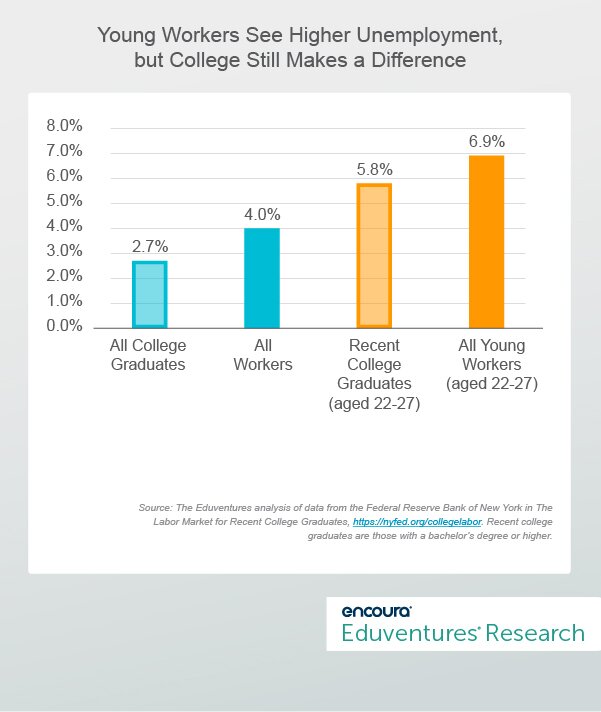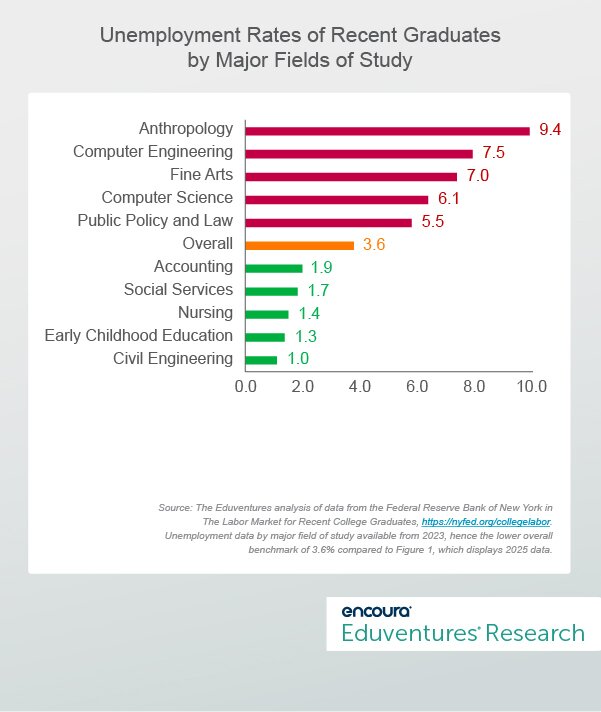While the month of May brings the excitement of commencement ceremonies and graduation festivities, the summer months usher in a hard reality for recent college graduates: finding a job.
Unfortunately, this task is more daunting this summer with the recent college graduate unemployment rate slowly ticking up. March 2025 data reveals an unemployment rate of 5.8% for this group—the highest since October 2013 (ignoring the wild pandemic disruption).
So, what else do we know about this trend and how do the numbers look among specific majors?
The Numbers in Context
Just two years ago, the recent college graduate unemployment rate (among those aged 22-27) stood at 4.1% (March 2023), similar to the 3.9% rate in March 2020, just before the massive pandemic disruption. In fact, today’s 5.8% rate is the highest unemployment rate for this group since October 2013 at 5.9% (again, ignoring an anomalous pandemic swing).
A number of articles have pointed to this trend with alarm:
- No hire, no fire: The worst job market for grads in years
- Rising number of college grads are unemployed, new research shows
- New college grads face a tougher job market – again
Critically, much of the college value debate has occurred over the last five years—a period mostly characterized by a strong labor market. If that tide turns, what happens to the value perception of higher education when an increasing number of graduates cannot find good jobs?
As usual, more nuances are needed to understand the current predicament.
What many recent articles do not point out is that, while the unemployment rate for recent college graduates is indeed growing, it still beats the overall unemployment rate for all young workers (aged 22-27). Figure 1 shows key unemployment rate segmentations from March 2025.

Figure 1
In fact, the college-specific segmentations beat total unemployment rates both overall and for younger workers. From this angle, the benefits of college still stand out.
There are, however, some reasons to keep a close eye on these trends. For example, the gap between the recent college graduate unemployment rates and that of all young workers appears to be shrinking. As shown in Figure 1, this gap was 1.1% in March 2025, but back in March 2023, it was 2.4%. The 10-year average gap is 3.4%.
What’s going on?
For one, a trade war with ever-moving tariff “deals” breeds economic uncertainty. Economic uncertainty slows investment and dampens the growth outlook. These, in turn, lead to hiring freezes and job cuts. For instance, one recent report details how employers announced 105,441 job cuts in April—up 63% from the same month last year—citing economic conditions and new technology.
This last piece, on new technology, is particularly notable. Recent research from Oxford Economics, a global economic advisory firm, puts it bluntly: “Higher unemployment among recent college graduates is primarily a function of a structural shift in hiring in the tech sector amid strong labor supply growth. While some of it is related to a normalization after the post-pandemic surge, there are signs that entry-level positions are being displaced by artificial intelligence at higher rates.”
Oxford Economics points to AI as a potential cause without citing the full extent of its influence. Therefore, the jury is still out on the rate at which AI is reshaping entry-level jobs, but it does appear that young, college-educated, white-collar workers are catching the brunt of current labor market dynamics—despite college still paying off overall.
Field of Study Insights
Of course, unemployment rates vary greatly by major.
Figure 2 displays unemployment rates for recent college graduates across a sample of major fields of study.

Figure 2
If you were not aware of the structural shifts in the tech sector, Figure 2 would be shocking. In fact, it still might be. Recent graduates in computer science programs, for example, see unemployment rates closer to that of fine arts graduates than the overall average. The same can be said for recent computer engineering graduates who see unemployment rates closer to that of anthropology majors than the overall average.
Meanwhile, recent college graduates majoring in accounting and education see unemployment rates below 2%—perhaps ironic given recent enrollment trends in those fields (e.g., undergraduate enrollment in accounting programs fell 20% between 2018-2023).
Or is it ironic? The fact that there are fewer accounting graduates today bodes well for accounting students given the current professional demand and associated shortages. The same can be said for teachers where local and school-specific shortages persist.
On the other hand, the surge of enrollment in technology-aligned programs may be reaching a point of labor market saturation given the developments in that space—like AI and fewer jobs. For example, the same jobs report referenced above notes that (so far this year), “Technology companies have announced a total of 64,118 cuts. This is up 35% from the 47,436 cuts announced during the same period last year.”
This suggests the numbers in Figure 2 could become bleaker for graduates from those programs.
The Bottom Line
The labor market is tough to predict even during stable economic conditions. Sprinkle in a little trade war and rapidly changing technology with massive societal implications, and predictions become even harder. If AI is indeed starting to reshape the labor market for recent college graduates, we must remember that disruption always comes before opportunity.
There is hope that, in addition to eliminating certain jobs, AI will create many new jobs for the future as well. It’s up to colleges and universities to ensure graduates are ready for those opportunities.
The challenge we see when studying Figure 2 is not that computer science and computer engineering majors now see above-average rates of unemployment. It’s that computer science and computer engineering majors, in addition to anthropology and fine arts majors, now see above average rates of unemployment. This raises critical questions about how to prepare all graduates, no matter their majors, for the future of work.
Of course, the unemployment rate is just one metric by which to judge the labor market opportunity for specific fields of study. Stay tuned for Part 2 of this Wake-Up Call to see a fuller picture develop.

